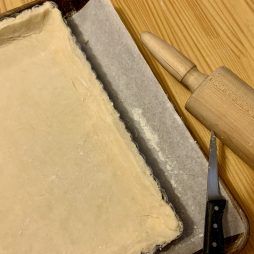

This is one of my favorite go to pie pastry recipes. It’s been around a long time. I found it in an old pie book, can’t recall where but I’ve tweaked it a bit here and there over the years. So slab pie is just a pie that is baked in a sheet pan–this recipe is written for a quarter sheet pan. But it can be used for a tart pan or a pie dish. You’ll have some scraps leftover after trimming that you can use on top for fancy trim or in dibs and dabs for a rustic touch. I like slab pies because of the proportion of filling to dough is a bit different than a traditional pie dish but the beauty here is use it however you like. I love it because it’s so easy to whiz up in a processor or even with your fingers if you like doing it that way. It’s easy to work with–even if you don’t roll it out, it can be pressed into a tart pan, sheet pan or pie dish. Be sure and chill it well before baking. The baked texture is lovely. It freezes well if you want to do it ahead of time. Which brings me to this. Make this dough this weekend or one evening next week and it will be done, ready and waiting for you to fill. Use it for an unbaked pie, such as a custard pie or a baked pie, such as pecan or pumpkin. Instructions for both are included. This is my go to recipe for quiche crust too! Enjoy the bake!

![]()
© 2021 Onion Creek Kitchens. All Rights Reserved.